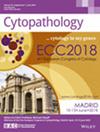The Modified Masood Scoring Index (MMSI) categorizes breast fine needle aspirates into four categories non-proliferative breast diseases (PBD), PBD without atypia, PBD with atypia and carcinoma in situ/carcinoma. The International Academy of Cytology Yokohama System classifies the aspirates into five categories – inadequate, benign, atypical, suspicious, and malignant. Very few studies have been conducted so far to compare the diagnostic accuracy of this system.
The objectives of the study were to classify breast fine needle aspirates according to the MMSI and IAC Yokohama and assess their risk of malignancy (ROM) and performance parameters.
All breast FNAs received from June 2020 to May 2023 were classified according to the MMSI and IAC Yokohama. Using histopathological diagnosis as the gold standard, ROM and performance parameters were calculated.
Out of the 559 breast fine needle aspirates, the histopathological correlation was available for 337 cases. The ROM for non-PBD, PBD without atypia, PBD with atypia and carcinoma in situ/carcinoma categories were 0%, 1.2%, 9.1% and 93%, respectively. The ROM for each of the categories of Yokohama system was 16.6%, 1.1%, 4.3%, 86.2% and 97.6%, respectively. The values for the sensitivity, specificity, PPV, NPV and diagnostic accuracy were slightly higher for IAC Yokohama (97.3%, 97.2%, 94.7%, 98.6% and 97.2%, respectively) than the MMSI (96.4%, 96.2%, 93%, 98.1% and 96.3%, respectively). Furthermore, another shortfall of MMSI is the inability to compare the Inadequate category of the Yokohama system.
Overall Yokohama system proved to be a better system for categorizing breast lesions on FNAB as the scoring system provides more objective categorization and minimizes false positive and false negative cases.



